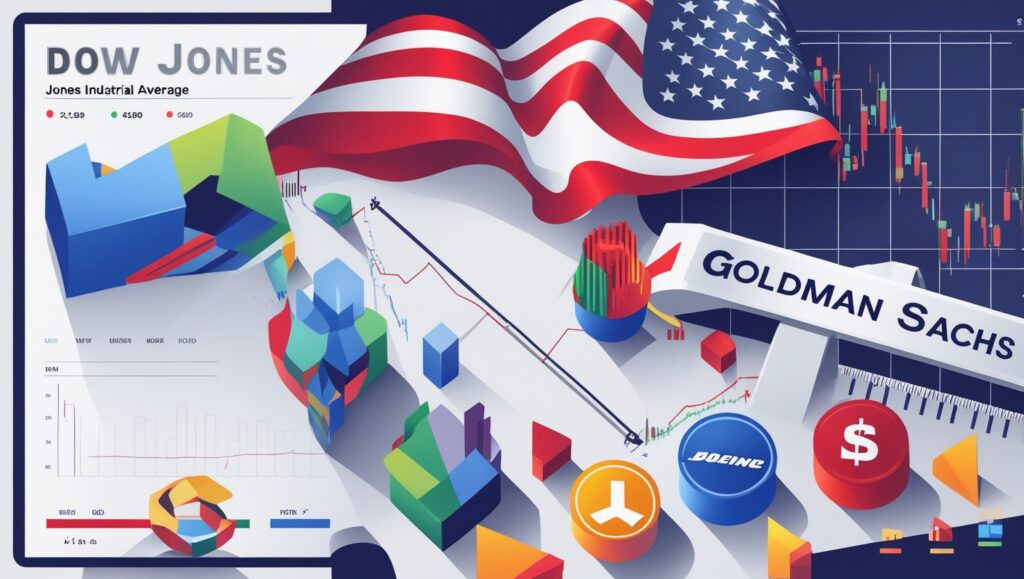Introduction to the Dow Jones
In the world of investment and financial markets, only a few names have as much weight as Dow Jones. This index is officially known as the Dow Jones Industrial Array Average (DJIA), and is the basis of financial reporting and a key indicator of performance in the US market. Over a century of insight into the health of the American economy and has been a benchmark for investors around the world.
Dow Jones isn’t just about numbers on screen. It reflects the heartbeat of corporate America, the trust of investors, and the changing economic mood. Understanding Dow Jones means understanding how global finances work.
What Is the Dow Jones Industrial Average (DJIA)?
Dow Jones Industrial Average (DJIA) is a cheap stock market index pursued by 30 well-known companies listed on US exchanges. It is one of the oldest and most extensive stock indexes in the world.
It was created in 1896 by Charles Dow and Edward Jones. In contrast to the broader S&P 500, including 500 companies, Dow Jones focuses on 30 blue-chip companies considered industry managers.
Key characteristics:
- Composed of 30 U.S.-based, large-cap companies
- Reflects market leadership and industrial strength
- Used as a barometer for U.S. economic health
History and Evolution of the Dow Jones
Dow Jones started with only 12 industrial companies, including companies in sectors such as tobacco, sugar and oil. Over the years since the economy developed, the index was expanded to 30 companies, paying numerous changes to reflect changing industrial and economic realities.
Major historical points:
- 1896: Dow Jones Industrial Average is launched
- 1928: Expands to 30 stocks, the number it holds today
- 1987: Dow experiences its worst single-day drop (Black Monday)
- 1999: Hits 10,000 points for the first time
- 2020: Plummets during COVID-19 but rebounds quickly
As industries rise and fall, the index is updated to remain relevant. For example, tech giants like Apple and Microsoft have replaced older manufacturing-based firms.
Key Components of the Dow Jones Index
The Dow is made of 30 principal organizations decided on via way of means of the editors of The Wall Street Journal. These corporations are selected primarily based totally on their reputation, sustained growth, and significance to the economy.
Top sectors represented:
- Technology (Apple, Microsoft, Intel)
- Financials (Goldman Sachs, JPMorgan Chase)
- Healthcare (Johnson & Johnson, Merck)
- Industrials (Boeing, 3M)
Inclusion criteria:
- U.S.-based companies
- Leading firms in key industries
- Strong financial health and performance
- Considered “blue-chip” stocks
This selective nature gives the Dow its high visibility and prestige.
How the Dow Jones Is Calculated
Unlike most modern indices, which are market-cap weighted, the Dow uses a price-weighted formula. This means that companies with higher stock prices have a larger influence on the index than those with lower prices.
Formula:
iniCopyEditDJIA = Sum of all 30 stock prices ÷ Dow Divisor
The Dow Divisor is a proprietary number that accounts for stock splits and dividends, keeping the index stable over time.
Example:
- If Company A’s stock is $200 and Company B’s is $50, Company A will have 4x the impact on the index—even if Company B is worth more by market cap.
Criticism often centers on this methodology because it can distort actual economic weighting.
Major Milestones in Dow Jones History
Understanding the Dow’s journey helps contextualize its current role.
Notable milestones:
- 1906: Breaks 100 points
- 1972: Crosses 1,000 points
- 1999: Surpasses 10,000
- 2008: Drops 777 points in one day (financial crisis)
- 2020: Recovers from COVID-19 crash, crosses 30,000
Each of these milestones reflects significant economic and geopolitical events that shaped market behavior.
Dow Jones vs Other Stock Market Indices
The Dow isn’t the only major index. Others include:
| Index | No. of Companies | Weighting | Focus |
|---|---|---|---|
| Dow Jones | 30 | Price | Blue-chip U.S. stocks |
| S&P 500 | 500 | Market Cap | Broader U.S. market |
| Nasdaq | 3,000+ | Market Cap | Tech and growth-oriented |
While the S&P 500 is broader and considered more representative of the total market, the Dow Jones remains popular due to its historical value and simplicity.
Importance of the Dow Jones to Investors
For investors, the Dow serves as a gauge of economic performance and investor sentiment.
Why it matters:
- Featured in financial headlines daily
- Used as a performance benchmark for portfolios
- Tracked globally for signals about U.S. economic health
Institutional investors, retail traders, and policy-makers all keep a close eye on the DJIA.

Factors Influencing Dow Jones Performance
Many variables affect the day-to-day and long-term performance of the Dow Jones.
Key influencers:
- Federal Reserve policy decisions
- Interest rate changes
- Inflation data
- Corporate earnings
- Global conflicts and trade deals
These factors can cause volatility or long-term trends in the index.
Historical Performance Analysis
Looking back at the Dow’s performance provides useful investment insights.
Average annual returns:
- 1926–2023: ~7% after inflation
- 1980s–1990s: Strong bull markets
- 2000s: Two major crashes
- 2010s–2020s: Resilience despite crises
Volatility: Though it fluctuates, the Dow has consistently recovered from downturns and rewarded long-term investors.
Notable Companies in the Dow Jones
Some of the most influential American companies are part of the Dow:
- Apple Inc. – Tech innovation leader
- Microsoft Corp. – Software and cloud giant
- The Boeing Co. – Aerospace and defense
- Goldman Sachs – Financial powerhouse
- Coca-Cola – Consumer goods titan
These firms shape not just the index but the economy itself.
How to Invest in the Dow Jones
You can’t directly buy the Dow, but you can invest in funds that track its performance.
Popular options:
- ETFs: SPDR Dow Jones Industrial Average ETF (DIA)
- Mutual Funds: Actively or passively managed funds
- Individual Stocks: Buy shares of the 30 companies
Advantages:
- Exposure to major U.S. companies
- Long-term growth potential
- Diversification within blue-chip stocks
Dow Jones During Financial Crises
The Dow has endured and recovered from numerous crises:
| Crisis | DJIA Impact | Recovery Period |
|---|---|---|
| Great Depression | Lost ~89% | Nearly a decade |
| Dot-com Bubble | Dropped ~38% | ~3 years |
| 2008 Financial Crash | Lost ~50% | Recovered by 2013 |
| COVID-19 Pandemic | Lost ~37% in weeks | Recovered within months |
These downturns underscore the value of patience and long-term investing.
The Role of Technology in Dow Jones Growth
Tech stocks have become a dominant force in the Dow.
Impact:
- Addition of Apple, Intel, Salesforce
- Reflects U.S. economic transition from industrial to digital
- Improved overall index performance
The Dow has evolved alongside the digital economy.
Criticism and Limitations of the Dow Jones
Despite its popularity, the Dow isn’t without flaws:
Critiques:
- Price-weighted system overemphasizes high-priced stocks
- Only 30 companies, which may not fully represent the economy
- Excludes smaller but fast-growing firms
For comprehensive exposure, many prefer the S&P 500 or Nasdaq.
Recent Trends and Predictions
The Dow continues to evolve with changing market dynamics.
Emerging trends:
- ESG investing gaining traction
- AI and automation affecting major companies
- Ongoing shift toward renewable energy and tech innovation
Analysts predict continued growth, tempered by interest rate policies and global uncertainty.
Tips for Following the Dow Jones
To stay informed:
- Watch financial news daily (CNBC, Bloomberg)
- Use stock market apps like Robinhood or Fidelity
- Monitor Federal Reserve meetings
- Look at earnings seasons and economic indicators
Tools and Platforms to Track the Dow Jones
Recommended platforms:
- Bloomberg: Professional-grade insights
- Yahoo Finance: Free and easy-to-use
- TradingView: Technical charts and community features
- Google Finance: Real-time updates
- Investing.com: Global coverage
These platforms help analyze trends and spot opportunities.
FAQs about the Dow Jones
Q: Why is it called the Dow Jones?
A: Named after its founders—Charles Dow and Edward Jones.
Q: How often is the Dow Jones updated?
A: Every second during market hours.
Q: Is the Dow Jones a good investment?
A: It’s a solid indicator and investment option for those seeking blue-chip exposure.
Q: Can international investors track or invest in the Dow?
A: Yes, via ETFs and online brokers worldwide.
Q: What’s the Dow’s long-term return?
A: Around 7% annually after inflation.
Conclusion
The Dow Jones is an important compass for investors, economists and analysts. Its deep history, selective composition, and permanent association make it more than just a number – it is a symbol of economic resilience and progress.
Whether you are an experienced investor or start, understanding the Dow is extremely important for a well-discovered financial decision. Remember that – not because it tells the entire story, but because it conveys the important part of it.
